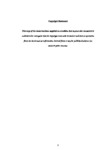Intimacy, identity and loyalty: Exploring the mediation pathways towards donor loyalty and the moderating role of donor identity esteem
| dc.contributor.supervisor | Hudson, Jane | |
| dc.contributor.author | Kong, Dejie | |
| dc.contributor.other | Plymouth Business School | en_US |
| dc.date.accessioned | 2022-07-21T13:20:31Z | |
| dc.date.issued | 2022 | |
| dc.identifier | 10506772 | en_US |
| dc.identifier.uri | http://hdl.handle.net/10026.1/19423 | |
| dc.description.abstract |
As the global economic and political situation is increasingly prominent, donor loyalty is one of the biggest challenges facing the charity sector in many countries today. Research in fundraising has shown that even a small improvement in donor loyalty can have a huge impact on charity income in the long term. Although marketing scholars have examined factors such as trust, commitment and satisfaction—the key to drive donor loyalty — the complex nature of donors’ underlying psychological processes toward donor loyalty remains unclear. This thesis aims to enhance our understanding of donor loyalty by studying the role of intimacy and donor identity esteem in donors’ psychological processes. Building on the marketing and social psychology literature, it explores the mediating pathways involving intimacy and other loyalty factors trust and commitment, as well as the moderating role of donor identity esteem in donors’ psychological processes. It employs mixed quantitative methods including a field survey and an online experiment on multiple samples including UK donors and the US general population. The results of this research demonstrate the mediating role of intimacy and the moderating role of donor identity esteem in the psychological process towards donor loyalty. Field Survey 1 reveals that intimacy has a positive direct effect on donor loyalty and mediates the effect of trust on donor loyalty through commitment. When donor identity esteem is higher, the effect of trust on intimacy and the effect of commitment on donor loyalty are stronger, while the effects of intimacy on commitment and loyalty are weaker. Online Experiment 2 confirms the findings from the earlier study and further explores the process by which donors’ feelings of intimacy transmit to commitment. The results reveal that donors’ intimacy transmits to commitment through both inward/self- reinforcing and outward/other-caring pathways, and the level of these effects depends on the level of donor identity esteem. Higher donor identity esteem strengthens one’s inward/self-reinforcing pathway while it weakens the outward/other-caring pathway. This study expands the scope of relationship fundraising and contributes to nonprofit marketing and psychology research since it introduces the concept of intimacy into the fundraising context and reveals the complexity of donors’ psychological process towards loyalty. The findings can be useful for understanding the psychological mechanisms of charity supporters and may encourage future research and better practices on the subject pursuant to the goal of a sustainable and meaningful donor-charity relationship. | en_US |
| dc.language.iso | en | |
| dc.publisher | University of Plymouth | |
| dc.subject | Fundraising | en_US |
| dc.subject | Donor loyalty | en_US |
| dc.subject | Intimacy | en_US |
| dc.subject | Donor identity esteem | en_US |
| dc.subject.classification | PhD | en_US |
| dc.title | Intimacy, identity and loyalty: Exploring the mediation pathways towards donor loyalty and the moderating role of donor identity esteem | en_US |
| dc.type | Thesis | |
| plymouth.version | publishable | en_US |
| dc.identifier.doi | http://dx.doi.org/10.24382/1198 | |
| dc.identifier.doi | http://dx.doi.org/10.24382/1198 | |
| dc.rights.embargodate | 2023-07-21T13:20:31Z | |
| dc.rights.embargoperiod | 12 months | en_US |
| dc.type.qualification | Doctorate | en_US |
| rioxxterms.version | NA | |
| plymouth.orcid.id | 0000-0002-5975-7150 | en_US |
Files in this item
This item appears in the following Collection(s)
-
01 Research Theses Main Collection
Research Theses Main


